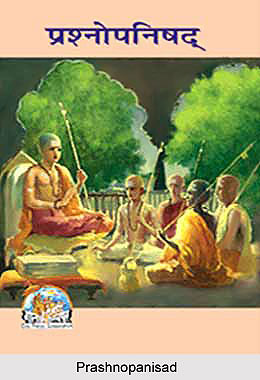 Prashnopanisad forms a part of the Atharva Veda. The Upanishad is a conversation between a rishi called Pippalada and his six disciples. All the six disciples sought elucidation and clarification of their philosophical and spiritual doubts from the rishi.
Prashnopanisad forms a part of the Atharva Veda. The Upanishad is a conversation between a rishi called Pippalada and his six disciples. All the six disciples sought elucidation and clarification of their philosophical and spiritual doubts from the rishi.
The Prashnopanisad has its status and authority but it serves the main purpose of explaining the mantras. It is true that the questions which the disciples ask are individual in nature but in the real sense of the term they are very useful for a Vedantik seeker. The questions have the power with the help of which an individual reaches a position to find out the ultimate truth of life.
The first question in Prashnopanisad deals with the problem of Creation in the pluralistic world and hence, includes the concept of objects that is present in this world. The question is answered in such a way that it instills the importance of Vairagya or detachment into the minds of the disciple. It tries to make the disciple understand that the world of objects are ephemeral in nature and the beauty of such objects is apparent, the true beauty lies in the world of detachment.
The second and the third question deals with the methods of initial meditation or Sadhana that is necessary for a seeker in order to integrate his mind perfectly so that he is able to step on the paths of Vedic meditation. As the Guru or the Rishi advises on the methods of upasana he has also asked the disciples to make a clear analysis of individual bodies and find out the essence of the five sense organs which aid to seek Knowledge and to realise the vital air or the Prana inside the body of individuals.
The fourth and the fifth question have given an extra emphasis on the nature of the dreamer and the sleeper. Last but not the least that is the sixth query tries to bring forth the glory of the Self in Eternal light. The sixth question has the potential to show an individual the path which would lead him towards the Temple of his Fulfilment.
Just like all the other Upanishads the Prashnopanisad also starts with a peace invocation but the peace invocation in this particular Upanishad is not a meek and humble surrender. Rather it is an invocation of all the potentialities that are already present within us. It is a prayer in the truest sense which inspires the potentialities within us and hence leads us towards the path of mental integration. The peace invocation of the Prashnopanisad is:
`Om bhadram karnebhih srnuyama devah bhadram pasyem-asksabhir-yajatrah, Sthirair-angais-tustuvagm-sastanubhih vyasema devahitam yadayuh. Svasti na indro vrddha-sravah svasti nah pusa visva-vedah, Svasti nas-tarksyo arista-nemih svasti no brhaspatir-dadhatu.
Om Santih! Om Santih! Om Santih!`
The meaning of this invocation is:
`O Gods, May we hear with our ears (always) what is auspicious; O Worshipful Ones, may we with our eyes see (always) what is auspicious. May we live the entire length of our allotted life hale and hearty offering our praises (unto Thee). May Indra, the ancient and the famous, Pusan (Sun) the all-knowing, the Lord of Swift Motion Vayu who saves us from all harms and Brihaspati who protects the spiritual wealth in usbless us (with the intellectual strength to understand the scriptures and the heroic heart to follow the teachings.)
Om Peace be! Peace be!! Peace be!!!`
In this Upanishad it is found that both the master and the disciples cry for peace, health, tranquility and strength of the whole world. They seek these blessings not only for the human world but for the entire world of creatures which have been created by the Almighty.
Throughout the discourse of Prashnopanisad the sage or rishi continually emphasises on carrying out of ones duty with utmost sincerity. The Master says that spiritual culture is a Temple built on the rocky foundations of renunciation and sacrifice. It says that if every human being carries out his duty then it will be easy to change the ugly face of the nation. The Prashnopanisad emphasizes that when individuals lead the divine life of a sage all the problems of the nations will be eradicated. The invocation of the Prashnopanisad loudly proclaims that one who has led the life of renunciation and has followed the path of Universal love, for him all the problems of life is a child`s play and can easily be tackled.
According to the Prashnopanisad the entire world of matter is finite and the only permanent principle in them is that all of them are impermanent. It says that there is a fourth plane of consciousness which is more often not recognised by human beings and this fourth plane of consciousness is in fact the Eternal Truth. This Eternal Truth in turn is the Conscious Principle and is an all pervading entity. The all pervading entity does not depend on the intellectual cognitions or spiritual experiences of any age.
The Upanishad says that the discovery of the Truth is not an accidental gift to mankind rather it is the right of every individual. It is the right of every individual to realise the True nature and seek the fundamentals of inner life. It is necessary to seek the essence of inner life in order to annihilate all the negative energies of life.
The flashes of knowledge that were received from the six queries of the disciples were sheaths of knowledge and were known as mantras. The mantras in turn help in the realisation of the super-human and godly intuitions.
Thus it can be said that the Prashnopanisad gives us insight about the true path which should be followed by an individual in order to seek the Absolute Truth of Life.












